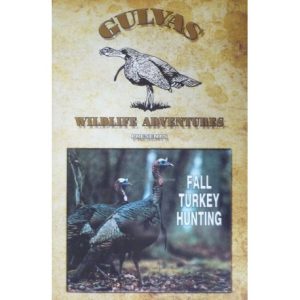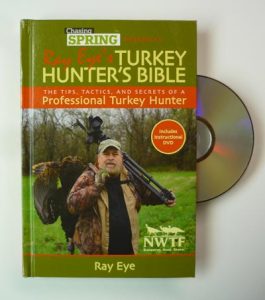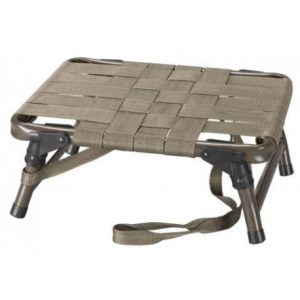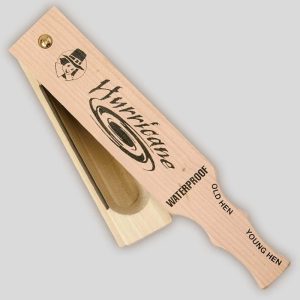  |
LOCATING FALL TURKEYSAlthough calling is critical, locating a fall flock to hunt is often the most difficult challenge to face fall turkey hunters. A simple three-word formula for locating fall turkeys, especially hens with juvenile flocks, is woods, water and fields. The needs of young birds are more critical than adult birds and these three terrain features each provide important requirements.
Mature hardwoods or pines are the safe haven. Here the flock finds hard mast (acorns, beechnuts) and soft mast (grapes), and roosting sites. Water is ideally in the form of an all-season creek. The birds conveniently access this water source at various locations along its coarse. Fields or pasture is a bonus. Seek it out as the third adjacent terrain feature. Open areas are a source of abundant insect life in the late summer and early fall. This is a protein rich food source for the young poults. Adult hens seem to realize its importance as they direct their flocks daily through open areas. These open areas are often the creek bottoms that show up as flat ground adjacent to creeks on topo maps. On aerial photos, pastures are the expansive, lighter colored areas. Extensive scouting for the above habitat combination pays off. Look for droppings, feathers and scratchings. Once a flock is located in such an area, the odds are good that a flock will be present each fall in the future. |
| HUNTING STRATEGIESStrategies for hunting once a fall flock is located can be grouped into three main categories: flock-busting, ambush and cruisin’ and callin’.
Flock-busting is an effective strategy that can be used whenever turkeys are encountered; on the roost, feeding in the forest or in an open pasture. The key element in a successful bust is surprise. Give the flock as little time as possible to react to your appearance. The quicker they must disperse, the more erratic will be their paths of flight. A flock spread in many directions will have to communicate by sound to regroup giving the hunter an opportunity to intercept with calling. After a flock has been busted, set up nearby in the direction most of the birds went. When the first calls are heard, answer with the same call but try to add more urgency. If a mature hen begins yelping, get up and run her off, for her offspring would surely choose her voice over your calling. To ambush a fall bird, know their daily travel pattern, set up along the route and wait. Travel patterns are most predictable in the early hours after leaving the roost and late in the afternoon returning to the roost. Turkeys like deer may take alternate paths through the same area. Two hunters can cover several travel routes at the same time. Successful ambushes can also be accomplished by glassing fields and pastures for feeding flocks, then repositioning to intercept them somewhere in the direction they are traveling. Here again, two hunters can cover two different exit routes. The third strategy for fall hunting, ‘Cruisin’ & Callin’ involves walking a lot of ground and occasionally calling. Spend your time in areas where turkey sign is present. Ridge top paths are a good choice because the hunter is able to direct his calling into two separate hollows or draws, by walking a short distance across the top of the ridge. On a calm day a flock may also be heard scratching and feeding along the ridge side. Unlike deer tracks that may be made at night, all turkey scratchings you encounter were made during the daytime and are a clear indication that turkeys travel here. Chiggers and Ticks are often active during early Fall hunts. For protection against these pests, consider GameHide’s ElimiTick, tick repellent clothing. |
 |
 |
‘CALLIN’The ‘Callin’ part of ‘Cruising and Calling’ may take several forms. At each stop begin with one or two clucks in case a bird is nearby. Take time to listen for a response. After a few moments, yelp 2 or 3 times. A reply might come in the form of a single yelp or cluck. Two seasons past, while walking and calling along a cornfield edge at the base of a ridge, a single yelp came from up in the hardwoods. It was faint enough to be uncertain but clear enough to be worth a set-up. We backed up to trees and yelped back. Soon an adult hen brought a flock of six over a rise and into range. If, after soft calling at a location and no response is heard, try a more urgent calling approach.
Urgent calling can take several forms in the fall hunting strategy. Kee keeing, and kee kee yelping may bring response from a lost hen or jake that is separated from a flock. The solo jake in the beginning of the story called often and loud as he came in to my coarse and raspy kee kee yelping on the tube call. If the boss hen of a flock answers your kee kees, she may swing her group close enough to give you an opportunity to join up. The opportunity for a shot is often sudden, so be ready. A second urgent calling sequence is ‘Lost Yelping’ or ‘Assembly Yelping’. Although slightly different, each is made up of a long series of fifteen to twenty yelps or more. Lost yelping comes from a bird that is separate from the group and in a panic. The series often starts low, then rises in volume to a loud and pleading finish. Coarser calls are on the jake bird’s wavelength and will get his attention. Assembly yelping, also a long series of yelps is more monotone in volume and primarily used by an adult hen to bring her separated group back together. For the hunter, assembly yelping will sometimes bring lost birds in and will often stir up the territorial instincts of a nearby boss hen, causing her to bring her flock into range. This type of yelping on a deep, raspy sounding slate or box is often very effective in locating fall turkeys. Copyright © 2017 Midwest Turkey Call Supply, All rights reserved. |

